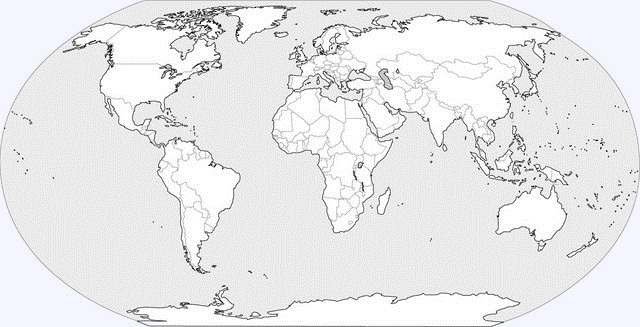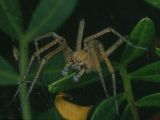|
Nombre común en ingles:
Long-fanged
six-eyed spiders
Nombre común en castellano:
Se desconoce
Familias similares:
Género tipo:
Dysdera Latreille, 1804
Diagnosis: Medium-sized araneomorph spiders;
two three tarsal claws; ecribellate; haplogyne; six eyes a distinct
pair of tracheal spiracles posterior to booklung slits; female
genitalia with posterior spermatheca; sternum joined to carapace by
intercoxal sclerites, chelicerae and fangs well developed.
Caracteres descriptivos:
Caparazón: longer than wide; clypeus narrow; fovea
reduced to a longitudinal black stripe; not nested;
integument sclerotized, usually with fine granulation. Esternón: joined to carapace by intercoxal sclerites.
Ojos: six; in compact group near clypeal edge. Quelíceros: free, well-developed; subchelate;
cheliceral furrow with 3-5 teeth; fangs well developed;
lamina absent. Piezas bucales: labium longer than wide, usually with
a deep notch at anterior edge; endites parallel. Patas: two or three claws; at least tibiae and
metatarsi of hind legs with setae. Palpo femenino: claw present, without teeth.
Abdomen: oboid; usually with sparse cover of short
setae. Hileras: anterior spinnerets three-segmented, apical
segment longest; colulus absent. Sistema respiratorio: two booklungs; two distinct
pairs of spiracles; anterior pair leading to booklungs,
posterior pair situated behind epigastric groove, leading to
tracheae. Genitalia: haplogyne; female genitalia with anterior
and posterior spermathecae and internal sclerite (endogyne);
male palp variable; tarsus short or long; bulbus originating
medioventrally on cymbium. Tamaño corporal: 2.5-20 mm.
Color: carapace and legs brown, black, yellow, orange
or red, abdomen usually grey.
Estatus taxonómico:
Forster & Platnick (1985) separated the Segestriinae from the
Dysderidae and validated it as a separate family. They recognised
the monophyly of the superfamily Dysderoidea, which also comprises
the Segestriidae, Orsolobidae and Oonopidae.
Distribución: The
Dysderidae is a Western Palearctic family with remarkably small
areas of distribution of particular species. Dysdera crocata has
been introduced worldwide.

Estilo de vida: Dysderids
are free-living norturnal wandering spiders of the ground layer or
tree trunks. They spend daylight in a silken retreat. Many species
are troglobitic, Dysdera has a prey specialisation in woodlice.
Bibliografía:
-
Alicata, P. 1964. Le Dysdera del gruppo andreinii della fauna
italiana (Araneae, Dysderidae). Atti Accad. gioenia Sci. nat. (6)
16: 67-86.
-
Arnedo, M.A., Oromí, P. & Ribera, C. 1997. Radiation of the genus
Dysdera (Araneae, Haplogynae, Dysderidae) in the Canary Islands: The
western islands. Zool. Scripta 25: 241-274.
-
Arnedo, M.A., Oromí, P. & Ribera, C. 2000. Systematics of the genus
Dysdera (Araneae, Dysderidae) in the eastern Canary Islands. J.
Arachnol. 28: 261-292.
-
Arnedo, M.A. & Ribera, C. 1997. Radiation in the genus Dysdera (Araneae,
Haplogynae, Dysderidae) in the Canary Islands: The island of Gran
Canaria. Zool. Scripta 26: 205-243.
-
Arnedo, M.A. & Ribera, C. 1999. Radiation in the genus Dysdera (Araneae,
Dysderidae) in the Canary Islands: The island of Tenerife. J.
Arachnol. 27: 604-662.
-
Cooke, J.A.L. 1965. Spider genus Dysdera (Araneae, Dysderidae).
Nature 205: 1027-1028.
-
Deeleman-Reinhold, C.L. 1993. The genus Rhode and the harpacteine
genera Stalagtia, Folkia, Minotauria, and Kaemis (Araneae,
Dysderidae) of Yugoslavia and Crete, with remarks on the genus
Harpactea. Revue arachnol. 10: 105-135.
-
Deeleman-Reinhold, C.L. & Deeleman, P.R. 1988. Revision des
Dysderinae (Araneae, Dysderidae), les espèces méditerranéennes
occidentales exceptées. Tijdschr. Ent. 131: 141-269.
-
Dippenaar-Schoeman, A.S. & Jocqué,
R. 1997. African Spiders: An Identification Manual. Plant Protection
Res. Inst. Handbook, no. 9, Pretoria, 392 pp.
-
Ferrández, M.A. 1986. Las especies ibericas del género
Harpactocrates Simon, 1914 (Araneida: Dysderidae). Actas X Congr.
Int. Aracnol. 1: 337-348.
-
Forster, R.R. & Platnick, N.I. 1985. A review of the austral spider
family Orsolobidae (Arachnida, Araneae), with notes on the
superfamily Dysderoidea. Bull. Am. Mus. nat. Hist. 181: 1-230.
-
Ubick, D. 2005d. Dysderidae. p. 103 in Ubick, D., Paquin, P.,
Cushing, P. E. & Roth, V. (Eds) 2005. The Spiders of North America.
An Identification Manual. American Arachnological Society.
6 géneros y 59 especies presentes en la Península Ibérica:
|
| |
- D. affinis
Ferrández, 1996 |
| |
- D. alentejana
Ferrández, 1996 |
| |
- D. anonyma
Ferrández, 1984 |
| |
- D. aurgitana
Ferrández, 1996 |
| |
- D. baetica
Ferrández, 1984 |
| |
- D. bicornis
Fage, 1931 |
| |
- D.
castillonensis Ferrández, 1996 |
| |
- D.
cribrata Simon, 1882 |
| |
- D.
crocata C. L. Koch, 1838 |
| |
- D.
edumifera Ferrández, 1983 |
| |
- D. erythrina
(Walckenaer, 1802) |
| |
- D. espanoli
Ribera & Ferrández, 1986 |
| |
- D. falciformis
Barrientos & Ferrández, 1982 |
| |
- D. flavitarsis
Simon, 1882 |
| |
- D. fuscipes
Simon, 1882 |
| |
- D.
gamarrae Ferrández, 1984 |
| |
- D. helenae
Ferrández, 1996 |
| |
- D. inermis
Ferrández, 1984 |
| |
- D. lusitanica
Kulczynski, 1915 |
| |
- D. machadoi
Ferrández, 1996 |
| |
- D. mordax
L. Koch, 1882 |
| |
- D. mucronata
Simon, 1911 |
| |
- D. ortunoi
Ferrández, 1996 |
| |
- D. presai
Ferrández, 1984 |
| |
- D. scabricula
Simon, 1882 |
| |
- D. subsquarrosa
Simon, 1914 |
| |
- D. valentina
Ribera, 2004 |
| |
- D. veigai
Ferrández, 1984 |
| |
- D. vivesi
Ribera & Ferrández, 1986 |
|
| |
- H. aeruginosa
Barrientos, Espuny & Ascaso, 1994, |
| |
- H. algarvensis
Ferrández, 1990 |
| |
- H. blasi
Ribera & Ferrández, 1986 |
| |
- H. dufouri
(Thorell, 1873) |
| |
- H. fageli
Brignoli, 1980 |
| |
- H. gaditana
Pesarini, 1988 |
| |
- H. hispana
(Simon, 1882) |
| |
- H. hombergi
(Scopoli, 1763) |
| |
- H. magnibulbi
Machado & Ferrández, 1991 |
| |
- H. minocci
Ferrández, 1982 |
| |
- H. ortegai
Ribera & De Mas, 2003 |
| |
- H.
proxima Ferrández, 1990 |
| |
- H. sciakyi
Pesarini, 1988 |
| |
- H. serena
(Simon, 1907) |
| |
- H. stalitoides
Ribera, 1993 |
| |
- H. subiasi
Ferrández, 1990 |
|
| |
- H. cazorlensis
Ferrández, 1986 |
| |
- H. escuderoi
Ferrández, 1986 |
| |
- H. globifer
Ferrández, 1986 |
| |
- H. gredensis
Ferrández, 1986 |
| |
- H. gurdus
Simon, 1914, |
| |
- H. meridionalis
Ferrández & Martín, 1986 |
| |
- H. radulifer
Simon, 1914 |
| |
- H. ravastellus
Simon, 1914 |
|
| |
- P. cantabrorum
(Simon, 1914) |
| |
- P.
deminutus
(Denis, 1957) |
| |
- P. loboi
Jiménez-Valverde, Barriga & Moreno, 2006 |
| |
- P. teruelis
(Kraus, 1955) |
|
| |
- R. scutiventris
Simon, 1882 |
|
| |
- S. levantina
Ribera, 1982 |
| |
|
 |